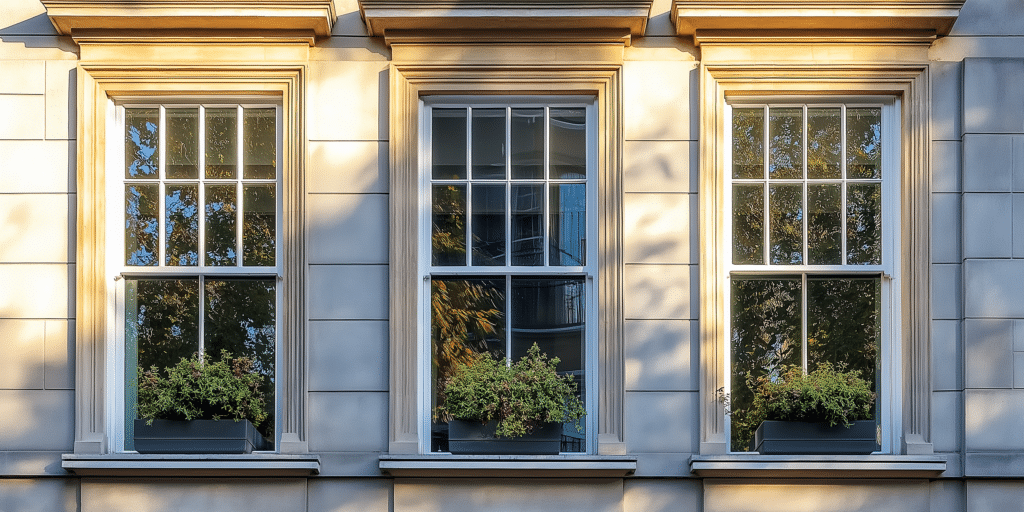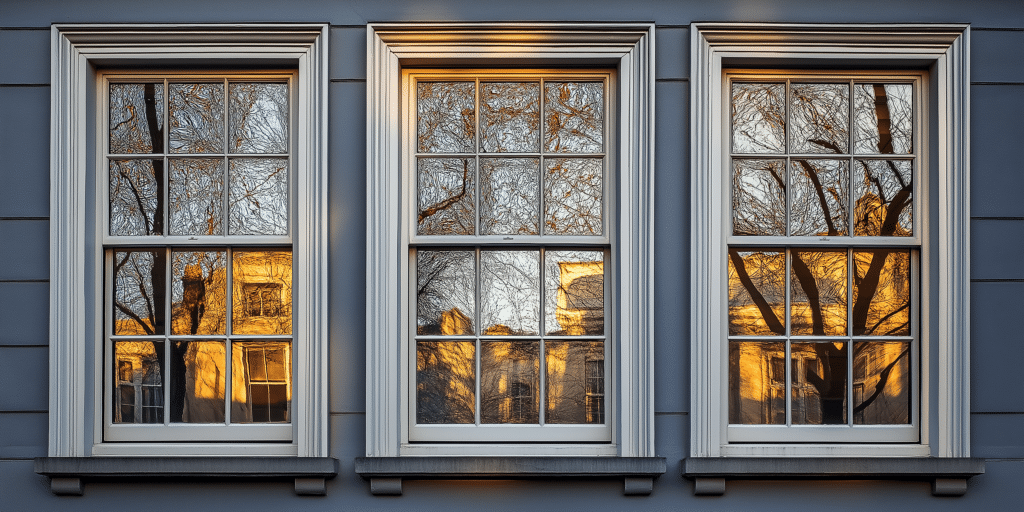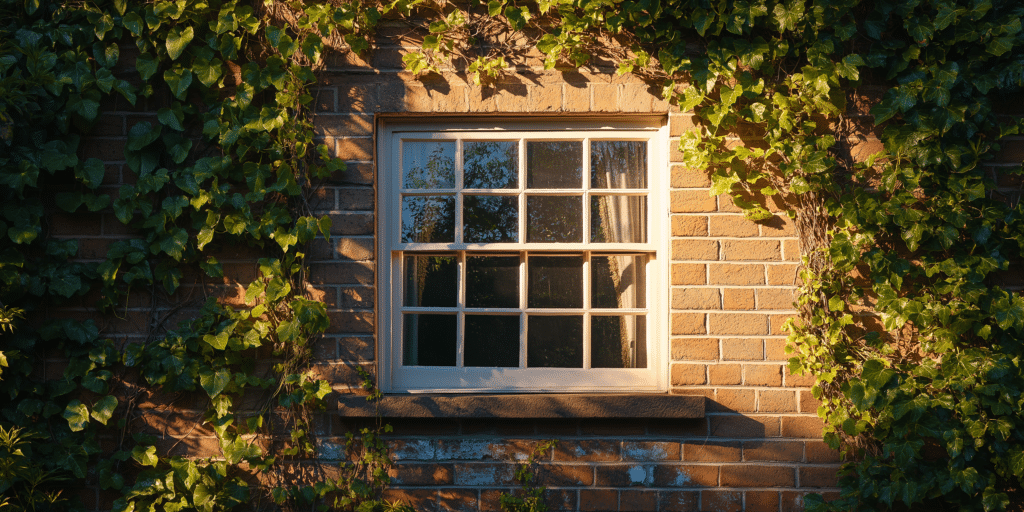Introduction: What is Sash Window Thermal Efficiency?

Sash windows, widely admired for their traditional aesthetic appeal and historical significance, are often perceived as lacking in thermal efficiency compared to more modern window designs. Significant advancements in window glazing technologies, frame materials, and installation techniques have drastically improved the thermal performance of sash windows. But what exactly is thermal efficiency when it comes to sash windows, and why does it matter for homeowners?
Thermal efficiency refers to a window’s ability to minimise heat transfer between the interior and exterior environments, essentially insulating the building and reducing energy loss. Energy-efficient sash windows play a pivotal role in maintaining a comfortable indoor temperature by reducing the reliance on heating systems in winter and cooling systems in summer. For example, studies have shown that upgrading from single-glazed to double-glazed sash windows can cut heat loss by up to 70% and reduce energy bills by 20-30% annually. Furthermore, the use of Low-E glass coatings and gas-filled cavities improves insulation, lowering a window’s U-value and enhancing its overall efficiency.
This makes retrofitting or replacing sash windows a worthwhile investment for reducing household energy consumption and increasing environmental sustainability. But can upgrading sash windows lead to significant energy bill reductions and improved environmental impact? The answer lies in understanding the role of materials, glazing, and design choices in optimising thermal efficiency.
How Is the Thermal Efficiency of Sash Windows Measured?
The thermal performance of sash windows is primarily measured using the U-value, but what does this technical term mean for homeowners? The U-value is a crucial metric that indicates the rate of heat transfer through the window. The lower the U-value, the better the window’s insulation properties.
The U-value measures the thermal transmittance of a window, with lower values indicating better insulation. For example, traditional single-glazed sash windows typically have high U-values, around 5.0 W/m²K, meaning significant heat loss. In contrast, double-glazed sash windows can achieve U-values as low as 1.6 W/m²K, a considerable improvement over single glazing. Recent innovations, such as triple glazing and Low-E coatings, can lower U-values even further to below 1.0 W/m²K.
Retrofitting solutions such as installing secondary glazing or using energy-efficient double-glazing units (DGUs) significantly enhance insulation. This ensures improved performance without compromising the window’s historical or aesthetic value. Furthermore, adding argon gas-filled cavities and modern, warm edge spacers can also help in reducing U-values, lowering energy consumption for heating by up to 30% [Green Building Guide].
Materials Matter: Choosing the Best for Energy Efficiency
The choice of frame material has a significant impact on a sash window’s thermal efficiency. Timber, uPVC, aluminium, and composite materials each offer varying degrees of insulation.
Timber sash windows have excellent insulation properties due to wood’s natural thermal resistance. However, untreated timber windows may experience warping or rot over time, requiring consistent maintenance. Modern treatments and sustainable timber options, like Accoya, improve durability while maintaining high insulation. Studies show that timber windows, when properly maintained, can outperform uPVC in terms of both thermal efficiency and sustainability.
On the other hand, uPVC sash windows offer a more affordable and low-maintenance solution, with reasonable insulation properties, though some argue they lack the aesthetic charm of timber. However, advancements in uPVC designs now offer enhanced insulation and recycling options, making them more eco-friendly. While sleek and durable, aluminium sash windows are less efficient insulators unless fitted with a thermal break, which reduces heat transfer through the metal.
Finally, composite sash windows combine the benefits of timber and aluminium, offering superior thermal performance and longevity. Though composite frames are costlier, they strike a balance between aesthetics and performance, often achieving U-values as low as 1.0 W/m²K [Passive House UK]. These options allow homeowners to choose based on their priorities of cost, appearance, and sustainability.
The Role of Glazing in Sash Window Thermal Efficiency

Glazing technology is essential in improving the thermal efficiency of sash windows. While single-glazed windows are notorious for their poor insulation, modern double-glazing and triple-glazing significantly enhance performance.
Traditional single-glazed sash windows are notorious for their high U-values, often exceeding 5.0 W/m²K. In contrast, double glazing, consisting of two panes separated by an insulating gap, can lower the U-value to around 1.6 W/m²K [Building Conservation Guide]. When using argon gas between the panes, this figure improves further, providing a significant reduction in heat loss.
Triple glazing improves on this by adding a third pane, reducing U-values even more—sometimes below 1.0 W/m²K. However, the additional weight and cost may not be necessary for homes in milder climates. Low-E glass, with its ability to reflect radiant heat, can also enhance thermal insulation, reducing heat loss by up to 25%. For older properties, retrofitting sash windows with double glazing or adding secondary glazing allows for improved energy efficiency without compromising on historic aesthetics.
Retrofitting Sash Windows for Improved Energy Efficiency
Retrofitting offers a way to upgrade existing sash windows without replacing them entirely, making it a popular solution for maintaining a property’s historical integrity.
Retrofitting options for sash windows include draught-proofing, secondary glazing, and upgrading to energy-efficient glazing units. Draught-proofing involves sealing gaps around the window frame to prevent air leakage, improving insulation by up to 80% in some cases. Draughts can lead to significant heat loss, particularly in older homes, so minimising them is crucial for energy efficiency.
Secondary glazing, where an additional glass pane is fitted to the interior of the existing window, provides another effective method to enhance energy efficiency. This reduces heat transfer while maintaining the sash window’s original appearance. Combined with weatherstripping, a process that seals the perimeter of the window, these retrofits significantly improve thermal insulation while maintaining the window’s historic charm.
Double-Glazing vs. Triple-Glazing: Which is Best for Sash Windows?
When deciding between double glazing and triple glazing, homeowners must carefully consider factors such as climate, cost, and energy savings. Both options significantly improve thermal efficiency, but they vary in terms of practicality and financial viability.
Double glazing is often the more practical and cost-effective solution for most homeowners. It significantly improves energy efficiency, reducing heat loss by up to 50% compared to single glazing, and can achieve U-values of around 1.6 W/m²K. On the other hand, triple glazing can achieve even lower U-values of below 1.0 W/m²K but comes at a higher cost and weight, which may not be necessary in milder climates like much of the UK. While it offers better thermal efficiency, triple glazing is more suited for colder regions or homes that need to meet Passive House standards.
One factor to consider is the aesthetic impact. Due to its thickness, triple glazing may require stronger frames, potentially affecting the period charm of sash windows. For this reason, many heritage homes opt for double glazing, which balances energy savings and retaining the property’s original look. In milder climates, double glazing is often sufficient to achieve significant energy savings and improved thermal comfort, especially when paired with other insulation improvements like draught-proofing.
Common Thermal Efficiency Concerns with Historic Sash Windows

Homeowners with historic or period properties often face the challenge of improving energy efficiency while maintaining the building’s original character. However, advancements in restoration techniques now allow for improved thermal performance without sacrificing the window’s historic appeal.
For historic sash windows, improving energy efficiency often involves retrofitting techniques such as secondary glazing, draught-proofing, and using thermally efficient glass. Secondary glazing involves installing an additional layer behind the original sash window, improving insulation without altering the external appearance. This technique is particularly effective for listed buildings, where making structural changes may be restricted [Historic England].
In addition to secondary glazing, draught-proofing helps reduce air leaks, which can account for a significant portion of heat loss in older properties. Using sustainable timber and restoration methods approved by conservation authorities ensures that the window’s historical integrity is maintained while enhancing its energy efficiency. Legal restrictions on listed buildings, particularly in the UK, mean that homeowners should consult with specialists before embarking on upgrades to ensure compliance [Heritage Conservation].
Environmental Impact: Sash Windows and Sustainability
Energy-efficient sash windows contribute to environmental sustainability by reducing the home’s overall energy consumption. By improving thermal efficiency, homeowners can lower their carbon footprint and support global efforts to combat climate change.
Replacing or retrofitting sash windows with more energy-efficient alternatives helps to lower carbon emissions by reducing the need for heating and cooling. Studies show that double-glazed sash windows can lower energy consumption by up to 20% [Energy Saving Trust]. Furthermore, using materials like sustainably sourced timber and recyclable uPVC contributes to a lower environmental impact. The UK government also offers grants and incentives through schemes such as the Green Homes Grant, encouraging homeowners to make energy-efficient upgrades [Green Homes Grant].
Cost vs. Savings: Is It Worth Upgrading Sash Windows for Efficiency?
Upgrading sash windows to improve energy efficiency involves an upfront cost, but many homeowners question whether it is worth the investment. However, the decision often pays off when considering the long-term savings and the benefits to both comfort and property value.
The cost of retrofitting sash windows can vary depending on the scope of the upgrade. Double glazing can cost between £500 and £1,000 per window, while secondary glazing is often a more affordable option at around £250 to £400 per window [Which?]. Despite these upfront costs, homeowners can expect to save up to 30% on their energy bills annually, making the return on investment (ROI) achievable within five to ten years.
Furthermore, government-backed schemes like the Green Homes Grant and local council incentives may help reduce the financial burden of upgrading sash windows, further improving the ROI. Energy-efficient sash windows also enhance a home’s resale value, particularly in older properties where aesthetics and thermal efficiency are crucial factors in the buyer’s decision-making process.
Maintaining Energy Efficiency: Care and Maintenance of Sash Windows

Maintaining the energy efficiency of sash windows over time requires regular care and attention. Failing to do so can lead to a decline in thermal performance, which in turn may increase energy bills and reduce overall comfort. Proper maintenance ensures that sash windows continue to deliver optimal energy efficiency while retaining their traditional appearance.
Key maintenance practices include regular inspection for draughts and air leaks, which can significantly reduce the energy efficiency of sash windows. Weatherstripping and draught-proofing should be reapplied when necessary to prevent air infiltration. For windows with double or triple glazing, inspecting the seals for wear and tear is crucial. Seals that have deteriorated over time can lead to condensation between the glass panes, which affects insulation and visibility.
Cleaning the glazing and frames is also important for maintaining the thermal performance of sash windows. Dust and dirt can reduce the glazing’s insulating properties, so regular cleaning with non-abrasive materials is recommended. Furthermore, checking for moisture build-up and condensation issues is key in preventing long-term damage to the glazing and frames. Finally, sash windows should be inspected at least annually to identify and address any emerging maintenance issues before they worsen.
DIY vs. Professional Installation: What’s the Best Approach?
When considering upgrading sash windows for thermal efficiency, homeowners often debate whether to do it themselves or hire a professional. While certain improvements, such as draught-proofing, can be carried out as DIY projects, more complex retrofitting or installations may require professional expertise.
One of the main risks of DIY retrofitting is improper sealing or insulation. In many cases, poorly executed DIY upgrades can lead to air leaks or draughts, which can actually reduce the energy efficiency of the windows. Double glazing installation is a task best left to professionals, as improper fitting can affect the U-value and overall insulation of the windows [Energy Window Certification].
Additionally, professional installers bring specialised tools and expertise, ensuring that all components are correctly installed to maximise thermal efficiency. They also typically offer warranties on their work, providing peace of mind for homeowners. On the other hand, DIY enthusiasts may attempt small-scale tasks such as draught-proofing or applying weatherstripping, which can yield moderate energy efficiency improvements if done correctly.
Final Thoughts: Is Improving Sash Window Thermal Efficiency Worth It?
Investing in the thermal efficiency of your sash windows can bring a range of benefits, including energy savings, improved comfort, and an increase in property value. While the upfront costs of upgrading to double glazing or installing secondary glazing may seem significant, the long-term savings on energy bills and enhanced comfort levels make it a worthwhile investment.
Overall, enhancing the thermal efficiency of sash windows is a cost-effective way to reduce energy consumption by up to 30% annually. Energy-efficient windows also contribute to reducing carbon emissions and supporting a more sustainable lifestyle. For historic properties, careful retrofitting with heritage-approved methods can ensure that the home’s character remains intact while benefiting from modern energy-saving technologies.
Whether you are looking to reduce energy bills, increase your home’s value, or simply make your living environment more comfortable, improving the thermal efficiency of sash windows is a sound investment that pays off over time.




